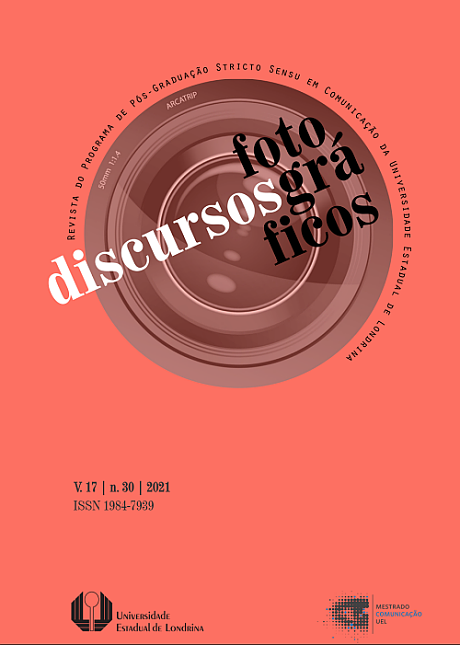Beauty and doom. Another proposal for an approach to the work of Dionisio González through the Brazilian favelas
DOI:
https://doi.org/10.5433/1984-7939.2021v17n30p28Keywords:
Beauty, Photography, Fatality, FavelaAbstract
The work of Dionisio González (Gijón, 1965) is inserted in the debate of architecture, home, and housing, gentrification, and real estate speculation, poorism (poverty tourism), the possibilities of socio-cultural development of a territory, etc. In this article we approach the photographic series of Brazilian favelas Cartografías para a Remoçao, made between 2004 and 2007, from another point of view: the beauty. We analyze his work based on binomials, highlighting among them the beauty-danger and/or beauty-fatality dichotomy.Downloads
References
BEN PENGLASE, Richard. Living with Insecurity in a Brazilian favela: urban violence and daily life. Nueva Jersey: Rutgers University Press, 2014.
BENJAMIN, Walter. La obra de arte en la época de su reproductibilidad técnica. Tradução de Andrés E. Weikert. México DF: Itaca, 2003.
CIUDAD de Dios. Direção: Fernando Meirelles. Roteiro: Bráulio Mantovani. [Rio de Janeiro]: Lumière Brasil, 2002. 1 DVD (125min).
DEBORD, Guy. La sociedad del espectáculo. Valencia: Pre-textos, 2015.
FOSCHI, Gigliola. Entrevista con Dionisio González. In: BARRO, David; GONZÁLEZ ROMERO, Dionisio; FOSCHI, Gigliola. La invisibilidad del resto. Sevilla: Cajasol Obra Social, 2007. p. 57-62.
FOUCAULT, Michel. El cuerpo utópico: las heterotopías. Buenos Aires: Ediciones Nueva Visión, 2010.
GARCÍA RANEDO, Mar. Heterotopías en la obra de Dionisio González. Estúdio Artistas sobre outrasObras, Lisboa, v. 4, n. 8, p. 289-296, 2013.
GONZÁLEZ, Dionísio. Cartografías para a Remoçao. 2021. Correo electrónico.
LÉVI-STRAUSS, Claude. Antropología estructural. Barcelona: Paidós, 1995.
LISSARDY, Gerardo. Los polémicos carteles con los que están "ocultando" las favelas para los Juegos Olímpicos de Río 2016. BBC News, Río de Janeiro, 21 jul. 2016. Disponible en: https://www.bbc.com/mundo/noticias-america-latina-36842318. Acceso en: 15 jul. 2020.
LLANDERAL, Eleonora. Revitalización espacial: crónica de una dependencia. Buenos Aires: Editorial Fadu, 2008.
MOREIRA ALVES, Maria; EVANSON, Philip. Living in the Crossfire: favela residents, drug dealers, and police violence in Rio de Janeiro. Penssylvania: Temple University Press Philadephia, 2011.
RILKE, Rainer Maria. Elegías de Duino: los sonetos a orfeo. 14. ed. Madrid: Cátedra, 2004.
RODRÍGUEZ VALLS, Francisco. La quiebra de los trascendentales en el sujeto humano: pluralidad, mentira, maldad y fealdad. In: RODRÍGUEZ VALLS, Francisco. ¿Qué es la antropología? Sevilla: Editorial Senderos, 2020.p. 87-108.
SALMON, Christian. Kate Moss Machine. Barcelona: Ediciones Península, 2010.
SAMANIEGO, Alberto Ruiz. Ser y no ser: figuras en el dominio de lo espectral. Murcia: Micromegas, 2013.
SONTAG, Susan. Sobre la fotografía. 2. ed. Barcelona: Penguin Random House, 2020.
TARKOVSKI, Andrey. Esculpir en el tiempo: reflexiones sobre el arte, la estética y la poética del cine. 17. Ed. Madrid: Ediciones Rialp, 2019.
Downloads
Published
How to Cite
Issue
Section
License
Copyright (c) 2021 Discursos Fotográficos

This work is licensed under a Creative Commons Attribution-NonCommercial 4.0 International License.
Discursos fotográficos adota a licença CC-BY-NC, esta licença permite copiar e redistribuir o material em qualquer meio ou formato, remixar, transformar e desenvolver o material, desde que não seja para fins comerciais. E deve-se atribuir o devido crédito ao criador.

Este obra está licenciado com uma Licença Creative Commons Atribuição-NãoComercial 4.0 Internacional.
















